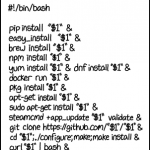My eldest kid – 11 at the time of writing – has been into Minecraft for some time now. I tried to motivate him on various ages to do some kinda programming with me. We tried Scratch, Lego Mindstorms (one of the few sets that is gathering dust) and a couple of other things. We didn’t have much fun with any of those. The nicest thing done together have been actually a couple of the Advent of Code challenges in which I tried to reduce to setup of things to a bare minimum (aka Texteditor).
I don’t blame the kid for failure at all… I am not a good teacher but what is worse, I have not much interest myself in tinkering with a game, never had (basically the same with regards to cycle, I prefer doing the thing actually), so I was quite happy that the kid himself wants to do stuff.
A bit of terminology
I was a bit surprised how many different kinds of Minecraft client and servers are out there:
First of all, there’s the Java based, “vanilla” server you can download here: original, “vanilla” Minecraft Java server. This edition of the server does not support custom plugins. It does however support Minecraft Forge. Forge is a modification loader for the vanilla server. You would program against the Forge API and that API encapsulates away the interaction with the server code.
Only the Minecraft Java edition client can connect against the Java server. This is a bit sad, as many friends of my kid would only have access to a gaming console. The Minecraft edition available on Switch, X-Box or Playstation does not support the Java server. They only connect to something called “Bedrock” edition.
Custom mods with MCreator
Back to Forge: Forge as the modloader must be installed into your Java Minecraft server via an installer that fits the server version. You get the installers here. After that you can pick and choose from a plethora of already existing mods at curseforge.
As far as I understood this, mods can also be installed client side only, but I don’t see the point of that when playing with multiple people on a server.
Anyway, we want to create our own mods. Mods can change many aspects of the games. They can include new commands, new recipes, blocks, bioms, creates, enchantments and more.
Adam Ness pointed me to MCreator. From the site: “MCreator is open source software used to make Minecraft Java Edition mods, Minecraft Bedrock Edition Add-Ons, and data packs using an intuitive easy-to-learn interface or with an integrated code editor.” This was exactly what I was looking for. A full fledged IDE but dedicated to Minecraft and the environment.
After download MCreator will setup a workspace for you. It uses Gradle behind the scenes to setup everything, including a development client and server. The nice thing here: You or your kid won’t need a Minecraft client license at that point. The documentation of the thing is stellar, it has an exhaustive Wiki and a good Knowledgebase.
MCreator contains tooling to package the mod and distribute it.
Custom plugins for the Spigot Minecraft server
I could stop here, as MCreator and the ability of mods to change a vanilla server is everything my kid was looking for, but for completeness and for fellow Java developers, here’s more.
There once was a fork of the Minecraft server called “Bukkit” but a little fluster cluck happened and now there’s Spigot. Spigot is something like a fork of the Minecraft server, but depends on the original binary (read the first link about to understand way). It does everything that the vanilla server does, but more. Especially it supports full fledged plugins.
To get started with developing plugins of any kind – btw, I know of one that uses Neo4j and Neo4j-OGM, yes, I helped the plugin author as part of my day job already – you first need to build the Spigot server. They don’t offer prebuild binaries due to the license mess (I found binaries at getbukkit.org but I am unsure about that being legit).
Building Spigot is pretty much trivial when you have a recent JDK installed on your machine. Grab the Spigot BuildTools.jar, save it somewhere and run in that directory java -jar BuildTools.jar to get a new server. I am unsure if you need to have Git installed for your machine (I have on all machines), but the build tools use it to clone a bunch of repositories.
After a while, you’ll find spigot-1.x.y.jar inside the same directory (at the time of writing, 1.16.4). This is your fresh Minecraft server supporting custom plugins.
How to write plugins? You can start of with a basic Maven project. The Spigot Plugin API lives under the following coordinates in the provided scope: org.spigotmc:spigot-api:1.16.4-R0.1-SNAPSHOT. They are not on central, so you would need to add the Spigot-Repo, too:
<repositories> <repository> <id>spigot-repo</id> <url>https://hub.spigotmc.org/nexus/content/repositories/snapshots/</url> </repository> </repositories> <dependencies> <dependency> <groupId>org.spigotmc:spigot-api:1.16.4-R0.1-SNAPSHOT</version> <scope>provided</scope> </dependency> </dependencies> |
The Spigot wiki gives more details.
The server version and naming a is a mess, not to speak about the licensing issues. But apart from that, I found the API pleasant to use: Spigot Java API docs. It gives full control about basically everything you can do in the game and I was able to create a simple plugin very fast.
To build the whole thing, you would need of course Maven or Gradle and some idea to set this up. I did install the Plugman plugin. This allows to load / unload / reload other plugins without restarting the server every time which cuts down on the feedback loop.
Summary
To sum this up: The various forks, versions, unclear naming of things regarded Minecraft is intimidating. People without much knowledge will eventually stumble from one YouTube “tutorial” to the next and download all sort of things in various qualities… After managing that initial step, things are not that bad and one can do neat things.
MCreator gives modders of all age great tooling without too much diversions in terms of installing things to express their minds about custom interactions in Minecraft. In a classroom situation or a scenario where a non-developer modern wants to try out things, I would recommend that.
Java developers will probably enjoy the Spigot API more. There’s even an IntelliJ plugin that creates full projects for you with the required setup.






One comment
Minecraft is not necessarily the first thing one would think of when talking about Java but, as it turns out, this popular game has what it takes to breathe new life into Java.
One Trackback/Pingback
[…] >> Minecraft Terminology for Java Developers [info.michael-simons.eu] […]
Post a Comment